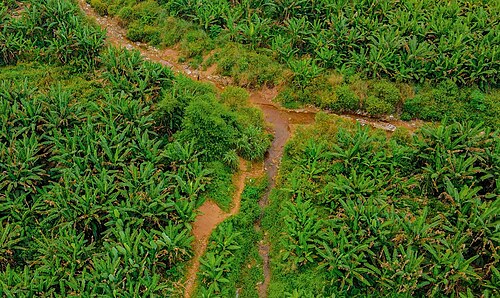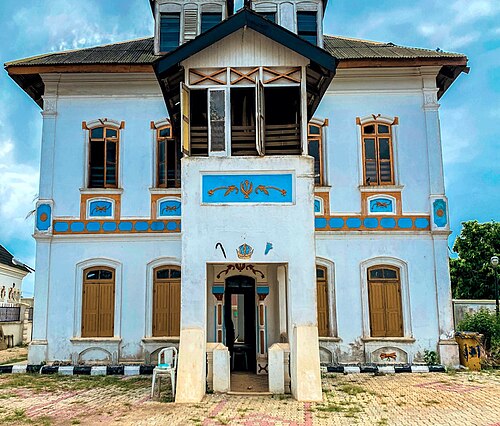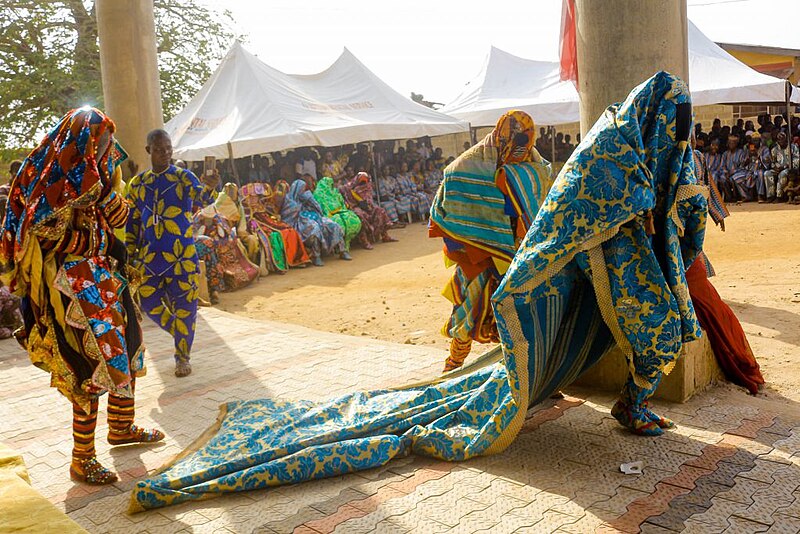Ota, Ogun
Ota (alternatively spelled Otta) is a town in Ogun State, Nigeria with an estimated 163,783 residents. Ota is the capital of the Ado–Odo/Ota Local Government Area. The traditional leader of Ota is the Olota of Ota, Oba Adeyemi AbdulKabir Obalanlege. Historically, Ota is the capital of the Awori Yoruba tribe.[1]
As of 1999, Ota has the third largest concentration of industries in Nigeria.[2] It also possesses a large market and an important road junction, found just north of the tollgate on the Lagos – Abeokuta Expressway. Ota is well known because it is home to Obasanjo Farms Nigeria Limited belonging to the former Nigerian president, Olusegun Obasanjo.
Otta is known as the home of some Yoruba ancient deities and festivals. Festivals usually celebrated in Otta includes Egungun festival, Iganmode Cultural Festival, Gelede Festival, etc.[3]
History
[edit]Ota is an ancient Awori kingdom whose existence dated back several millenniums ago. The town is acknowledged to be the first kingdom in the entire Awori land,[4] a sub- Yoruba ethnic group, known as the Awori Kingdom of "Ota" and equally ranks as one of the earliest or oldest kingdoms in Yoruba land. As an enviable and great kingdom of note, it has very strong, sacred, and, of course, fortress traditions of origin, custom, culture, history and anthropology spiced with ethnological settlements and certified prudence spanning several centuries.[5]
Ota's existence dates back to at least the period of Orunmila (a contemporaneous with the Orunmila) as an established and organized human habitation or community with Obaship institution that no one could ascribe any specific date thus since the BC era. There were very few settlements then what is known as Yorubaland today. Apart from Ile-ife, the first place or source, Ota is a very, very ancient city ranking behind Ile-Ife only that Orunmila first visited. Other few places Orunmila visited after Ota, for one reason or the other, included Ado-Ekiti, Irun Akoko, Ilawe and Ifon. No doubt, Orunmila visited Ota at least on three occasions as confirmed by Ifa-Irete Olota (Owonrin) Corpus and Odu Osa Meji (Odu Eleye).[6][7][8]
There had been Awori before Awori, and Ota stands the first long before arrival or emergence of Ogunfunminire and his Group between 15th and 17th centuries.[4][5][6] Aworis are many, not all the Aworis are children or descendants of Ogunfunminire or Olofin of Iseri Olofin. We had Olofins in Ota whose periods of migrations to Ota from Ife predated Iseri Olofin and others. The earliest Ota people set a fetish bowl according to Ifa divination on then river or stream, and sank on a river at Ota when others had not existed including Ogunfunminire, the progenitor of Isheri people but not the entire Aworiland because some Aworis denied vehemently the suggestion that their ancestors got to Isheri before moving to their present settlements. Nonetheless, Aworis are culturally linked up despite the differences in their mode or waves of migratory movements to what is known as Aworiland, Apart from Ota, there are other Awori towns whose ancestors bear Olofin not of Isheri, such towns include; Iworo, Imeke, Ado-odo, etc.
John Thabiti Willis in 2018[8] further adduced to the oral traditions known as Irete Olota (Owonrin) and Osa Meji in (Odu Eleye), IFA offers an alternative accounts of the originality and founding of Otta by the Terrestrial mothers commonly known as witches-Eleye or Iyami Osoronga; and have since domiciled Otta from antiquity offering strong support for the fact that a human community or existence preceded the migrations to Otta by Ife Oodaye and related people. These traditions, however chronicle the historical journey of Orunmila to Ota, the revered settlement of the renowned witches, Ilu Aje (or Ilu Olori Eleye Osoronga), typically translated as the city of "Terrestrial mothers". Furthermore, to corroborate the above assertion on the traditions origin and founding of Otta, “The Archive of sound and vision, institute of African studies, University of Ibadan, the guiding and preservation of Irete Olota (Owonrin)[9]
Ota today has grown from the ancient settlement founded by the Terrestrial mothers commonly known as witches-Eleye or Iyami Osoronga[8][9] into a thriving economic hub in Ogun State and Nigeria. Ota began to grow into the industrial city it is today due to the economic development planning and lobbying by the Manufacturers Association of Nigeria and Chief Bisi Onabanjo, former governor of Ogun State. This led to the official designation of Ota as an industrial town, and the state government began to encourage industries to locate in and around the city.[2]
Education
[edit]Traditionally, Ota only had a few schools, and all were sponsored by various Christian religious organizations. The Muslim community responded by forming a school operated by the Ansar-Ud-Deen Society. State schools began to be formed in the late 1970s, and there are now several private schools in the area. Iganmode Grammar School is the oldest, founded in 1960. Other notable schools include Ansar-Ud-deen Comprehensive College, Bells Comprehensive Secondary School and Faith Academy Secondary School.[10]
There are also two universities in Ota: Covenant University and Bells University of Technology. And a private polytechnic, Allover Central Polytechnic.[citation needed]
The Nigerian Navy's School of Music is also located in Ota.[11]
Economy
[edit]Sections of the town are dominated by industries including Lagos - Abeokuta road and Idi-iroko road. Beginning in the early 1970s, many businesses began building factories in Ota partly because it was less congested than the industrial estates in Lagos. Businesses with facilities in Ota include:
- Farmex Meyer Limited [12]
- Nigerian Breweries
- De United Foods Industries Limited[13]
- Unique Pharmaceuticals [14]
- Intercontinental Distillers Limited.
- Honda Manufacturing (Nigeria), Ltd[15]
- Veepee Industries Limited
Demographics
[edit]The indigenes are predominantly Yoruba of the Awori dialect group. They trace their ancestry down from Ile-Ife and consider Iganmode as their patriarch. Other Aworis are located in the neighboring Lagos State.[citation needed]
The main occupation of Ota residents is trading and farming. The town's proximity to Lagos and proximity to the border town of Idiroko have led to the creation of two large markets: Kayero Market in Sango and Oba T.T. Dada Market along Idiroko Road. These markets are each so large that they blend together and are more commonly just referred to as Sango-Ota Market.[3]
There are a number of both Public and private healthcare centers in Ota. They include The Local Government Maternity, Sango Ota Primary Health Centre. Private medical centers include Ace Medicare , St Shiloh Medical Center , Central Specialist Hospital, Ojugbele Specialist Hospital etc
Tourist Attractions in Ota
[edit]








Egungun Festival
[edit]
Ota is referred to as the mecca of Egungun deity and festival in Yoruba land.[16] The Egungun festival is part of the yoruba religious system sometimes referred to as Orisa.[16][17]
Egugun festival in Ota is usually ushered in ceremoniously, via a night before the d-day- tagged "Igbagan Day", meaning, a special night of blessing. The next day (Abode Oko) usually witnesses a jamboree of egungun with well over 178 notable family masquerades that will dance around the town under the leadership of the Ege- which is the head of the egunguns; and finally converged at the Oju Sango beside Enu-Owa in the evening. At this arena, the entire masquerade gave an insight into their acquired new skills and magical performances that were later displayed one after the other in a carnival-like environment.
Notable masquerades in otta numbering about 178 were classified into about 6 categories; in line with their functions and performances, namely: the Ege - which appeared to be the most beautiful, being the head of the masquerades came out in a well knitted expensive, colourful attire and covering it up with a highly decorated crown as a symbol of its authority.
But before proceeding to the square, the Ege, accompanied by the Egungun Alagbadas, would head to Iga Elerinko to pick the sere abalaye (ancestral bell charm) which will be used in making supplications for the city. Subsequently, it will return it and pick sere ide (decorative bell charm). With the sere ide, the Ege moves round the town along with other Egungun and participants, singing and dancing to the Bata drum.
It must be reiterated at this point that the Ege only comes out on this day. This is because it has performed its leading role at the commencement of the festival. This is closely followed by about 26 Alagbadas- whose appearance is also very expensive, fascinating and artistically colorful along with peculiar dancing steps and a demonstration of some magical dexterity. They are: Ayoka- Ibile, Ariwoola, Afebioye, Ayelabola, Ibu- owo, Labo Idire, Oya-Ogba, Ajofoyinbo (Iyesi), Owolafe, Ajofoyinbo (Ota), Obalolaye and Ayoka-Ese. Others are: Owolani, Eiyeba, Lebe-Oke, Labo-Ilawe, Lebe-Itimoko, Oya–Ijemo and Oya–Ikotun, all of which are danced and performed satisfactorily in quick succession at the square (Okede).
There are 38 other special masquerades called Olooguns. These sets of masquerades outfits are not really attractive. In fact, they are scary with sculpted artworks on their heads, but they are special in magical performances, thus cannot be easily ignored. There are also about 15, Baba-Mukomuko who are like prayer warriors and who also delivers messages from the dead to the living. The next in line are about 6 Alaredes - which specializes in dance and general entertainment of the people.[16]



Iganmode Cultural Festival Iganmode Cultural Festival
[edit]Iganmode Cultural festival (also known as Odun Omo Iganmode) is an annual festival celebrated by the Awori Yoruba people of the ancient city of Ota in Ogun State, Nigeria.[18] The week long annual festival usually takes place in December[19] of every year, to showcase the cultural, spiritual and mystical heritage of the Ota Awori people.[18][20] The festival is also a spiritual bugle , a home coming call for a cultural renaissance and re awakening call to all sons and daughters of Awori sub-nationality, in Lagos, Ogun, Osun, Republic of Benin, diaspora and wherever they be may be on the face of earth.[21][22][23]
History
[edit]The first edition of the festival was held in 1992 when the festival was then referred to as Iganmode Day. Over the years, the festival has hosted many prominent Nigerians and dignitaries, such as former Nigerian president Chief Olusegun Obasanjo, former Nigeria Attorney general and minister of justice the late Chief Bola Ige. others include former governors of Ogun State Chief Olusegun Osoba, Otunba Gbenga Daniel, Ibikunle Amosun and the present Governor and Deputy Governor Prince Dapo Abiodun[24] and Engr. Noimot Salako Oyedele (a native of Ota). Taiwo Ajayi Lycett amongst others. The festival has also been chaired by a number of eminent personalities such as Asiwaju Bola Tinubu, Sir Kesington Adebukunola Adebutu and Senator Musiliu Obanikoro[25]
Key Highlights
[edit]One of the major highlights of the festival is the display by Egungun Masquerades in Ota[26] Masquerade traditions are very sacred to the awori yoruba people of Ota[27][16]
Tourism
[edit]The festival is supported by the Ogun State Government.[21][28][29][30] The events of the festival are done with the spiritual and traditional blessings of the Olota of Ota. The festival also seeks to promote the tourism potentials of Ota, Ogun State and Nigeria[31][32][33]
It allows people to see different cultural displays and visits to tourist locations like the second storey building in Nigeria[34][35][36][37]
Other
[edit]References
[edit]- ^ P.C. Lloyd (1962). Yoruba Land Law. Oxford University Press. p. 225.
- ^ a b Ruhollah Ajibola Salako (1999). Ota: The Biography of the Foremost Awori Town. Penink & Co. p. 15.
- ^ a b Ruhollah Ajibola Salako (1999). Ota: The Biography of the Foremost Awori Town. Penink & Co. p. 16.
- ^ a b "Lagos belongs to Awori, the Bini met them there — Akintoye". Punch Newspapers. 17 December 2017. Retrieved 28 January 2023.
- ^ a b "History, the human anchor". The Guardian Nigeria. 11 May 2017. Retrieved 28 January 2023.
- ^ a b Akintoye, Stephen Adebanji (1 January 2010). A History of the Yoruba People. Amalion Publishing. ISBN 978-2-35926-027-4.
- ^ "OUR ANCESTORS ARE With The OLOTA - IFA PRIEST". Retrieved 28 January 2023.
- ^ a b c "Masquerading Politics". Indiana University Press. Retrieved 28 January 2023.
- ^ a b "Irete Owonrin - UCLA Library Digital Collections". ucla.edu. Retrieved 28 January 2023.
- ^ Ruhollah Ajibola Salako (1999). Ota: The Biography of the Foremost Awori Town. Penink & Co. pp. 16–17.
- ^ Ruhollah Ajibola Salako (1999). Ota: The Biography of the Foremost Awori Town. Penink & Co. p. 21.
- ^ "Farmex Meyer Official Website". Archived from the original on 7 November 2017. Retrieved 7 November 2017.
- ^ "De United Foods Industries Official Website". Archived from the original on 14 November 2017. Retrieved 7 November 2017.
- ^ Unique Pharmaceuticals Official Website
- ^ "Honda Manufacturing Official Website". Archived from the original on 8 November 2017. Retrieved 8 November 2017.
- ^ a b c d Albert, Larry. "The Significance of the Egungun Cultural Festival. A Case of Study of Ota, Aworiland, Ogun State by Olanrewaju Arepo.doc".
{{cite journal}}: Cite journal requires|journal=(help) - ^ IGANMODE CULTURAL FESTIVAL 202I, THE MECCA OF EGUNGUN FESTIVAL IN OTA AWORI KINGDOM, OGUN STATE (YouTube)
- ^ a b "Iganmode cultural festival to promote exquisite Awori tradition". The Guardian Nigeria News - Nigeria and World News. 6 November 2021. Retrieved 16 March 2023.
- ^ Adebayo, Sunday (4 November 2021). "Ota-Awori Kingdom Biggest Event, Iganmode Cultural Festival Set To Hold In December!". SocietyReporters.com. Retrieved 16 March 2023.
- ^ "Ota Holds Iganmode Cultural Festival December To Awaken Security Consciousness – Independent Newspaper Nigeria". Retrieved 16 March 2023.
- ^ a b "Govt to showcase Ota-Awori heritage with festival". Punch Newspapers. 14 November 2021. Retrieved 16 March 2023.
- ^ NNN (29 November 2019). "Iganmode Cultural Festival to attract industrialists, diaspora,others". NNN. Retrieved 2023-03-16.
- ^ "Odun Omo Iganmode: Social, Cultural Groups, Others, Enjoin to Support Celebration - The Gallant News". thegallantnews.com.ng. Retrieved 16 March 2023.
- ^ "Our social investment programme will employ over 40,000 people – Governor Abiodun". The Guardian Nigeria News - Nigeria and World News. 18 December 2022. Retrieved 16 March 2023.
- ^ Limited, Alamy. "Ota, Nigeria, 15th Dec. 2021 Masquerades perform during the annual Iganmode Cultural Festival 2021 held in Ota, Ogun State, Nigeria. The festival is held to showcase the cultural heritage of the Awori-Yoruba people. Credit: Adekunle Ajayi/Alamy Live News Stock Photo - Alamy". alamy.com. Retrieved 2023-03-16.
{{cite web}}:|last=has generic name (help) - ^ Limited, Alamy. "Ota, Nigeria (15 December 2021) Masquerades perform during the annual Iganmode Cultural Festival 2021 held in Ota, Ogun State, Nigeria. The festival is held to showcase the cultural heritage of the Awori-Yoruba people. Credit: Adekunle Ajayi/Alamy Live News Stock Photo - Alamy". alamy.com. Retrieved 16 March 2023.
{{cite web}}:|last=has generic name (help) - ^ "Masquerading Politics". Indiana University Press. Retrieved 16 March 2023.
- ^ Daily Post Staff (23 September 2022). "Ogun government declares support for 2022 Odun Omo Iganmode festival". Daily Post Nigeria. Retrieved 2023-03-16.
- ^ "Governor Dapo Abiodun Congratulates Olota of Otta on Odun Omo Iganmode Cultural Festival". New Telegraph. 9 December 2022. Retrieved 16 March 2023.
- ^ "Odun Omo Iganmode Has Attracted Investors Into The State- Dapo Abiodun Says As Festival Gets Underway". Voice of Awori. 9 December 2022. Retrieved 16 March 2023.
- ^ David (4 November 2021). "Iganmode Festival: Olota wants annual event added to tourism calendar". The Sun Nigeria. Retrieved 2023-03-16.
- ^ sunrise (27 November 2021). "Southwest ATPN drums support for Odun omo Iganmode". Sunrise News. Retrieved 16 March 2023.
- ^ "Royal Visit: New Olowu, Prof. Matemilola visits Prof.Obalanlege on Iganmode Day Celebration". thebusinesspackage.com.ng. Retrieved 16 March 2023.
- ^ newsheadline247. "Photos: Ogun Tourism revived as Nigeria's second storey building in Ota gets facelift | newsheadline247". Retrieved 16 March 2023.
{{cite web}}: CS1 maint: numeric names: authors list (link) - ^ Great, Dennis (8 August 2021). "The Second Storey Building In Nigeria". Big Time Africa Travels & Tours Company. Retrieved 16 March 2023.
- ^ "The second storey building in Nigeria, Ogun, Nigeria". soamaps.com. Retrieved 16 March 2023.
- ^ Online, Tribune (24 March 2020). "Dent in history as Nigeria's second storey building battles anonymity". Tribune Online. Retrieved 16 March 2023.
